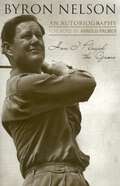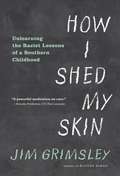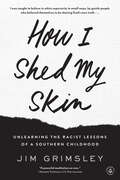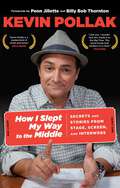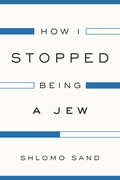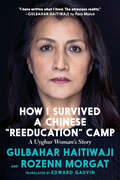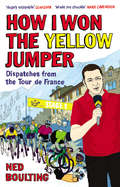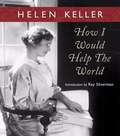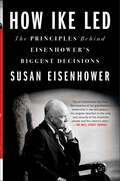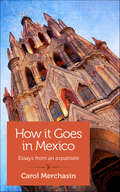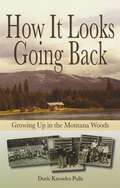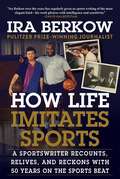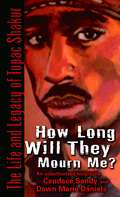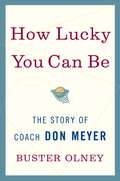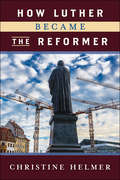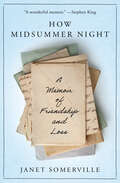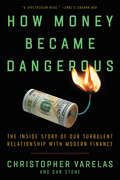- Table View
- List View
How I Met My Son
by Yolanda Bogert'The sky didn't fall, and our family didn't fall apart. We just started using different pronouns. Oh, I had to change the name stored in my phone with his number. That was a bit of a pain.' Yolanda Bogert, a mum from regional Queensland, made worldwide news when she placed a notice in a Brisbane newspaper in December 2014. It read: 'A Retraction. In 1995 we announced the arrival of our sprogget, Elizabeth Anne, as a daughter. He informs us that we were mistaken. Oops! Our bad. We would now like to present, our wonderful son - Kai Bogert. Loving you is the easiest thing in the world. Tidy your room.' This is the story of Yolanda and her son Kai. As a teenage mum, Yolanda formed a close-knit bond with her child. Now, together, Yolanda and Kai deal with issues of acceptance, religion and tradition in a heart-warming story of love in transition.
How I Met My Son
by Yolanda Bogert'The sky didn't fall, and our family didn't fall apart. We just started using different pronouns. Oh, I had to change the name stored in my phone with his number. That was a bit of a pain.' - Yolanda BogertYolanda Bogert, a mum from regional Queensland, made worldwide news when she placed a notice in a Brisbane newspaper in December 2014. It read: 'A Retraction. In 1995 we announced the arrival of our sprogget, Elizabeth Anne, as a daughter. He informs us that we were mistaken. Oops! Our bad. We would now like to present, our wonderful son - Kai Bogert. Loving you is the easiest thing in the world. Tidy your room.' In How I Met My Son, Yolanda tells of her son Kai, their loving family, and the laughter and struggles they've shared. As a teenage mum, Yolanda formed a close-knit bond with her child. Now, together, Yolanda and Kai deal with issues of acceptance, religion and tradition in a heart warming story of love in transition.
How I Played the Game: An Autobiography
by Byron NelsonByron Nelson was one of golf's greatest legends. He was one of the finest golfers ever to pick up a putter, and the man who had the most magnificent year any golfer has ever had—1945, when he won an incredible eighteen PGA tournaments, including eleven in a row, and finished second in seven others.How I Played the Game is the beautifully told tale, in his own words, of a man determined to be the best ever: his hardscrabble rural Texas upbringing and his near-death experience with typhoid fever; his early years as a caddie at Fort Worth's Glen Garden Country Club (where as a 15-year-old he beat another young caddie named Ben Hogan in the Caddie Championship); the lean years as an amateur and as a young pro during the Depression; and the golden years of the 1940s, when he invented the modern golf swing and forged the legend of "Lord Byron."Even after his sudden retirement (the real reason for which is finally revealed here) his impact on the game never lessened. Besides his many years as an insightful TV golf commentator, he was mentor to several future golf champions, Ken Venturi and Tom Watson among them. And he continued to play top-caliber golf with the greats of the game, like Hogan, Jack Nicklaus, and Arnold Palmer, and some who were less than great—President Eisenhower, Bing Crosby, Bob Hope, and a host of others.Laced throughout with scores of priceless stories, anecdotes, opinions, and even golf tips, and with an in-depth, event-by-event recreation of his golden year, 1945, How I Played the Game is golf writing and remembrance of the highest order—irresistible reading for every golfer and fan.
How I Saved the World
by Jesse WattersThe conservative political commentator shares his story—and his outlook on America’s future—in this #1 New York Times bestseller.In How I Saved the World, Jesse Watters takes readers on a tour of his life from basement-dwelling Fox minion to pampered champion of right-thinking Americans. He has divined great truths about the nature of our country while stumbling across beaches asking oblivious college students basic political questions and while stumbling out of Air Force One with the President.Interspersed are his thoughtful suggestions for overcoming left-wing radicalism, maintaining American democracy, moving beyond aging hippies (like his long-suffering, loving parents), saving the world from social justice warriors and the deep state—all while smirking his way through life in only the nicest way. Watters outlines the stark choice ahead of us between all-American hamburgers and leftist Green New Deal breadlines (okay, maybe that one is a no-brainer) and shows the way for order and fairness to be restored. A manifesto and a call-to-arms from a man for all seasons, How I Saved the World is a hilarious, enlightening, entertaining book with a reasonable chance of winning a Nobel Prize in every category, even chemistry.
How I Shed My Skin: Unlearning the Lessons of a Racist Childhood
by Jim GrimsleyMore than sixty years ago, the Supreme Court ruled in Brown v. Board of Education that America''s schools could no longer be segregated by race. Critically acclaimed novelist Jim Grimsley was eleven years old in 1966 when federally mandated integration of schools went into effect in the state and the school in his small eastern North Carolina town was first integrated. Until then, blacks and whites didn''t sit next to one another in a public space or eat in the same restaurants, and they certainly didn''t go to school together. Going to one of the private schools that almost immediately sprang up was not an option for Jim: his family was too poor to pay tuition, and while they shared the community''s dismay over the mixing of the races, they had no choice but to be on the front lines of his school''s desegregation. What he did not realize until he began to meet these new students was just how deeply ingrained his own prejudices were and how those prejudices had developed in him despite the fact that prior to starting sixth grade, he had actually never known any black people. Now, more than forty years later, Grimsley looks back at that school and those times--remembering his own first real encounters with black children and their culture. The result is a narrative both true and deeply moving. Jim takes readers into those classrooms and onto the playing fields as, ever so tentatively, alliances were forged and friendships established. And looking back from today''s perspective, he examines how far we have really come. "Does more to explain the South than anything I''ve read in a long, long time... Simply put, a brilliant book. While I was reading, I kept thinking two things. One, this is totally shocking. Two, it''s not at all shocking but a familiar part of my life and memory. Grimsley''s narrative is straightforward and plain spoken while at the same time achingly moving and intimately honest. " --Josephine Humphreys, author of No Where Else on Earth "I not only believed this account but was grateful to see it on the record... The boy in this narrative is becoming a man in a time of enormous change, and his point of view is like a razor cutting through a callus. Painful and healing. Forthright and enormously engaging. This is a book to collect and share and treasure. " --Dorothy Allison, author of Bastard Out of Carolina "Jim Grimsley''s unflinching self-examination of his own boyhood racial prejudices during the era of school desegregation is one of the most compelling memoirs of recent years. Vivid, precise, and utterly honest, "How I Shed My Skin" is a time machine of sorts, a reminder that our past is every bit as complex as our present, and that broad cultural changes are often intimate, personal, and idiosyncratic." --Dinty W. Moore, author of Between Panic and Desire "In all his beautiful works, Jim Grimsley has told hard, hidden truths in luminous, subtle prose... Here, he renders history not on the grand, sociological scale where it is usually written, but on very personal terms, where it is lived. This is an exquisite, careful story of a white boy of simple background and great innocence. " --Moira Crone, author of The Not Yet "Grimsley probes the past to discover what and how he learned about race, equality, and democracy... in this revelatory memoir. " --Kirkus Reviews "Acclaimed writer Grimsley offers a beautifully written coming-of-age recollection from the era of racial desegregation. " --Booklist, starred review
How I Shed My Skin: Unlearning the Racist Lessons of a Southern Childhood
by Jim GrimsleyMore than sixty years ago, the Supreme Court ruled in Brown v. Board of Education that America’s schools could no longer be segregated by race. Critically acclaimed novelist Jim Grimsley was eleven years old in 1966 when federally mandated integration of schools went into effect in the state and the school in his small eastern North Carolina town was first integrated. Until then, blacks and whites didn’t sit next to one another in a public space or eat in the same restaurants, and they certainly didn’t go to school together. Going to one of the private schools that almost immediately sprang up was not an option for Jim: his family was too poor to pay tuition, and while they shared the community’s dismay over the mixing of the races, they had no choice but to be on the front lines of his school’s desegregation. What he did not realize until he began to meet these new students was just how deeply ingrained his own prejudices were and how those prejudices had developed in him despite the fact that prior to starting sixth grade, he had actually never known any black people. Now, more than forty years later, Grimsley looks back at that school and those times--remembering his own first real encounters with black children and their culture. The result is a narrative both true and deeply moving. Jim takes readers into those classrooms and onto the playing fields as, ever so tentatively, alliances were forged and friendships established. And looking back from today’s perspective, he examines how far we have really come.
How I Slept My Way to the Middle: Secrets and Stories from Stage, Screen, and Interwebs
by Kevin PollakKevin Pollak rose through the comedy club ranks at the feet of Don Rickles and Bill Cosby, Johnny Carson and George Carlin. Named one of Comedy Central&’s Top 100 Stand-Up Comedians of All Time, he&’s a killer impressionist—Falk, Shatner, Walken, Nicholson—a versatile actor with one of the most respected filmographies around, and an Internet pioneer. He&’s done it all, and now he&’s ready to spill the beans. Ballsy, hilarious, and revealing, How I Slept My Way to the Middle winningly combines never-before-heard stories featuring A-list entertainers with fan favorites and Kevin&’s own thoughts about how he made it. He turned down his first invitation to do stand-up on The Tonight Show because he knew that he&’d make a bigger impact if he sat on the couch next to Johnny. That huge risk—which paid off in spades—was just the beginning. Find out how he brought John Belushi to his knees, tortured Paul Reiser (twice), bamboozled Larry King, stole Alan Arkin&’s soul, almost killed Warren Beatty, and sucked face with Robert DeNiro&’s girlfriend. Now a new media entrepreneur, he&’s laughing proof that if you follow your gut and believe in yourself, you can do anything you want—except have a rational conversation with Rip Torn, who&’s an evil, paranoid $#!%.
How I Stopped Being a Jew
by Shlomo Sand David FernbachShlomo Sand was born in 1946, in a displaced person's camp in Austria, to Jewish parents; the family later migrated to Palestine. As a young man, Sand came to question his Jewish identity, even that of a "secular Jew." With this meditative and thoughtful mixture of essay and personal recollection, he articulates the problems at the center of modern Jewish identity. How I Stopped Being a Jew discusses the negative effects of the Israeli exploitation of the "chosen people" myth and its "holocaust industry." Sand criticizes the fact that, in the current context, what "Jewish" means is, above all, not being Arab and reflects on the possibility of a secular, non-exclusive Israeli identity, beyond the legends of Zionism.From the Hardcover edition.
How I Survived a Chinese "Reeducation" Camp: A Uyghur Woman's Story
by Gulbahar Haitiwaji Rozenn MorgatThe first memoir about the "reeducation" camps by a Uyghur woman. &“I have written what I lived. The atrocious reality.&”— Gulbahar Haitiwaji to Paris MatchSince 2017, more than one million Uyghurs have been deported from their homes in the Xinjiang region of China to &“reeducation camps.&” The brutal repression of the Uyghurs, a Turkish-speaking Muslim ethnic group, has been denounced as genocide, and reported widely in media around the world. The Xinjiang Papers, revealed by the New York Times in 2019, expose the brutal repression of the Uyghur ethnicity by means of forced mass detention—the biggest since the time of Mao. Her name is Gulbahar Haitiwaji and she is the first Uyghur woman to write a memoir about the 'reeducation' camps. For three years Haitiwaji endured hundreds of hours of interrogations, torture, hunger, police violence, brainwashing, forced sterilization, freezing cold, and nights under blinding neon light in her prison cell. These camps are to China what the Gulags were to the USSR. The Chinese government denies that they are concentration camps, seeking to legitimize their existence in the name of the &“total fight against Islamic terrorism, infiltration and separatism,&” and calls them &“schools.&” But none of this is true. Gulbahar only escaped thanks to the relentless efforts of her daughter. Her courageous memoir is a terrifying portrait of the atrocities she endured in the Chinese gulag and how the treatment of the Uyghurs at the hands of the Chinese government is just the latest example of their oppression of independent minorities within Chinese borders. The Xinjiang region where the Uyghurs live is where the Chinese government wishes there to be a new &“silk route,&” connecting Asia to Europe, considered to be the most important political project of president Xi Jinping.
How I Won the Yellow Jumper: Dispatches from the Tour de France
by Ned Boulting'Paris, 4 July 2003: My first Tour de France. I had never seen a bike race. I had only vaguely heard of Lance Armstrong. I had no idea what I was doing there. Yet, that day I was broadcasting live on television. I fumbled my way through a few platitudes, before summing up with the words, "...Dave Millar just missing out on the Yellow Jumper." Yes, the Yellow Jumper.'Follow Ned Boulting's (occasionally excruciating) experiences covering the world's most famous cycling race. His story offers an insider's view of what really goes on behind the scenes of the Tour. From up-close-and-personal encounters with Lance Armstrong to bewildered mishaps with the local cuisine, Ned's been there, done that and got the crumpled-looking t-shirt. Eight Tours on from Ned's humbling debut, he has grown to respect, mock, adore and crave the race in equal measure. What's more, he has even started to understand it. Includes How Cav Won the Green Jersey: Short Dispatches from the 2011 Tour de France
How I Would Help the World
by Helen Keller Ray SilvermanHelen Keller's life was deeply changed when she began to read the writings of Emanuel Swedenborg in braille. Referring to him as "one of the noblest champions true Christianity has ever known," she said, "Swedenborg's message has been my greatest incitement to overcome limitations." Certainly, Helen Keller did much to help the world. But she felt she could help the world most by sharing with others the inspiration that came to her through reading Swedenborg's books. "Were I but capable," she said, "of interpreting to others one-half of the stimulating thoughts and noble sentiments that are buried in Swedenborg's writings, I should help them more than I am ever likely to in any other way. It would be such a joy to me if I might be the instrument of bringing Swedenborg to a world that is spiritually deaf and blind." Her essay, How I Would Help the World, is her attempt to do this. It is accompanied by an introduction by scholar Ray Silverman elucidating Helen Keller's spiritual process. This glimpse into the spiritual life of Helen Keller provides inspiration for those who may have wondered how she was able to find the strength and courage to overcome her triple handicap. Pictures of Helen Keller and direct quotations from the writings of Emanuel Swedenborg accompany her poignant words.
How Ike Led: The Principles Behind Eisenhower's Biggest Decisions
by Susan Eisenhower“Lays bare the essence of [President Eisenhower’s] leadership in war and peace—his singular devotion to the unity and security of the American people.” —The Wall Street JournalFew leaders have made decisions as momentous—and varied—as Dwight D. Eisenhower. From D-Day to Little Rock, from the Korean War to Cold War crises, from the Red Scare to the Missile Gap controversies, Ike was able to give our country eight years of peace and prosperity by relying on a core set of principles. These were informed by his heritage and upbringing, as well as his strong character and personal discipline—but he also avoided making himself the center of things. He was a man of judgment, and a steadying force. He sought national unity by pursuing a course he called the “Middle Way” that tried to make winners on both sides of any issue.Ike was a strategic, not an operational leader, who relied on a rigorous pursuit of the facts for decision-making. His talent for envisioning a whole, especially in the context of the long game, and his ability to see causes and various consequences, explains his success as Allied Commander and as President. After making a decision, he made himself accountable for it, recognizing that personal responsibility is the bedrock of sound principles.Written by his granddaughter, a policy analyst and national security expert, How Ike Led reveals the personality, beliefs, and habits that allowed Eisenhower to lead America through a transformational time.“As good a picture of Ike as we have ever had.” —David Nichols, author of Eisenhower 1956“Highly personal anecdotes supplement [the author’s] research. Armchair historians will treasure this book.” —BooklistIncludes photographs
How It Goes in Mexico: Essays from an Expatriate
by Carol MerchasinCarol Merchasin first visited San Miguel de Allende in 2005, fell in love with its language, people, and culture, and moved there full-time with her husband shortly thereafter. A lawyer by training, Merchasin is curious about how everything around her in Mexico works—the health care system, religious rituals, loaning money, small change at the market, narcotrafficantes, telenovelas, and the subtleties between the verbs ser and estar. An intrepid researcher, she informally consults her neighbors, history books, and experts until she’s satisfied. In How It Goes in Mexico, her essays are by turns funny and poignant, and her portrayal of Mexico is neither romantic nor wary, but respectful and compassionate.
How It Looks Going Back: Growing Up in the Montana Woods
by Doris Knowles PulisIn 1949, taking a break from San Diego&’s post–World War II bustle, the Knowles family went camping in Canada. Heading home through northwest Montana&’s Yaak River country, they found a two-bedroom, story-and-half log cabin on a small lake.There was neither electricity nor plumbing. Access was via dirt road, slow at best and iffy during the long, hard winters. Darwin Knowles saw a peaceful life, and adventurous wife Marilyn agreed. Third-grader daughter, Dee (for Doris), could attend the one-room school, and three-year-old Bob (Barbara) have a safe place to play. Enthusiastic but ignorant of wilderness living, the family moved in that fall—working together to cook and heat with wood, hunt and fish for food, haul water, and wash clothes by hand.They stayed for six years, during which son Stevie was born. Dee&’s reminiscence of her childhood in &“the Yaak&” presents quirky neighbors, growing girls&’ adventures, wildlife huge and tiny, and especially one loving family. As she writes, &“It was a cozy, scary, painful, hilarious, dangerous, interesting, and grand time, and the most fun I ever had.&”
How Life Imitates Sports: A Sportswriter Recounts, Relives, and Reckons with 50 Years on the Sports Beat
by Ira BerkowMemorable Stories From a Half Century of Sports Journalism For the last half century, Pulitzer Prize–winning sportswriter Ira Berkow has been at the center of some of the most memorable moments in sports history. From the World Series, NBA Finals, and Super Bowl, to Heavyweight Title Fights, the Olympics, and The Masters, he has seen and covered them all. After fifty years covering sports, with more than twenty-five as a journalist for the New York Times, How Life Imitates Sports shares how these events—and their participants—have significantly shaped how we as a nation have come to understand and perceive our culture (and even our politics). They are a historical record of one significant sphere of our life and times: sports. From Muhammad Ali to Mike Tyson, Michael Jordan to LeBron James, Jackie Robinson to Derek Jeter, Billie Jean King to Tonya Harding, O. J. Simpson to Tiger Woods and beyond, this collection is a historical record of our times over this past half century, in terms of society, race and gender, politics, legal issues, and the fabric of our sports passions and human condition, ranging from pathos to humor, from introspection to perception. Including additional commentary on when these events first occurred and how they have impacted us today, Berkow shares the knowledge of someone who sat ringside, in the press box, and on the sidelines for some of the most notable moments in our history. So whether you&’re a fan of baseball and basketball, or tennis and soccer, How Life Imitates Sports shows you our history from someone who witnessed it first-hand; a worthy collection for anyone who appreciates the highest quality sports journalism.
How Lincoln Learned to Read: Twelve Great Americans and the Educations That Made Them
by Daniel WolffBeginning with Benjamin Franklin and ending with Elvis Presley, author Daniel Wolff creates a series of intimate, interlocking profiles of notable Americans that track the nations developing notion of what it means to get a good education.
How Literature Saved My Life
by David Shields"Reading How Literature Saved My Life is like getting to listen in on a really great, smart, provocative conversation. The book is not straightforward, it resists any single interpretation, and it seems to me to constitute nothing less than a new form." --Whitney Otto In this wonderfully intelligent, stunningly honest, painfully funny book, acclaimed writer David Shields uses himself as a representative for all readers and writers who seek to find salvation in literature. Blending confessional criticism and anthropological autobiography, Shields explores the power of literature (from Blaise Pascal's Pensées to Maggie Nelson's Bluets, Renata Adler's Speedboat to Proust's Remembrance of Things Past) to make life survivable, maybe even endurable. Shields evokes his deeply divided personality (his "ridiculous" ambivalence), his character flaws, his woes, his serious despairs. Books are his life raft, but when they come to feel un-lifelike and archaic, he revels in a new kind of art that is based heavily on quotation and consciousness. And he shares with us a final irony: he wants "literature to assuage human loneliness, but nothing can assuage human loneliness. Literature doesn't lie about this--which is what makes it essential." A captivating, thought-provoking, utterly original way of thinking about the essential acts of reading and writing.
How Long Will They Mourn Me?: The Life and Legacy of Tupac Shakur
by Dawn Marie Daniels Candace Sandy"Buried as a g while tha whole world remembers me" -Tupac Shakur, from "Until the End of Time" Tupac Shakur was larger than life. A gifted rapper, actor, and poet, he was fearless, prolific, and controversial-and often said that he never expected to live past the age of thirty. He was right. On September 13, 1996, he died of gunshot wounds at age twenty-five. But even ten years after Tupac's tragic passing, the impact of his life and talent continues to flourish. Lauded as one of the greatest hip-hop artists of all time, Tupac has sold more than sixty-seven million records worldwide, making him the top-selling rapper ever. How Long Will They Mourn Me? celebrates Tupac's unforgettable life-his rise to fame; his tumultuous dark side marked by sex, drugs, and violence; and the indelible legacy he left behind. Although Tupac's murder remains unsolved, the spirit of this legendary artist is far from forgotten. How long will we mourn him? Fans worldwide will grieve his untimely death for a long time to come.
How Lucky You Can Be: The Story of Coach Don Meyer
by Buster OlneyIn September 2008, Northern State University men#x19;s basketball coach Don Meyer stood on the brink of immortality. He was about to surpass the legendary Bobby Knight to become the all-time NCAA wins leader in men#x19;s basketball. Then, on a two-lane road in South Dakota, everything changed in an instant. InHow Lucky You Can Be, acclaimed sports journalist Buster Olney tells the remarkable story of the successive tragedies that befell Coach Meyer but could not defeat him. Laid low by a horrific car accident that led to the amputation of his left leg below the knee, Coach Meyer had barely emerged from surgery when his doctors informed him that he also had terminal cancer. In the blink of an eye, this prototypical 24/7 workaholic coach-who arrived at the gym most mornings before 6 a. m. -found himself forced to reexamine his priorities at the age of sixty-three. A model of reserve, Coach Meyer had sacrificed much of his emotional life to his program. His wife, Carmen, felt disconnected because of his habitual reticence, while his three children-all now well into adulthood-had long had to compete with basketball for his attention. With sensitivity and skill, Olney shows how Coach Meyer mined his physical ordeal for the spiritual strength to transform his life. In the months that followed his accident and diagnosis, he reached out to family, friends, and former players in a way he had never been able to do before, making the most of this one last opportunity to tell those close to him how he felt about them-and in turn he received an outpouring of affirmation that confirmed how deeply he had affected others. Sustained throughout an often painful recovery by his love of basketball, he would return to the court once more-with a newfound appreciation for the game#x19;s place in his life. The inspirational story of a life renewed by unimaginable hardship,How Lucky You Can Beproves that it#x19;s never too late to start making changes-and reminds us that fortune can smile upon us even in our most trying hours. From the Hardcover edition.
How Luther Became the Reformer
by Christine HelmerNo story has been more foundational to triumphalist accounts of Western modernity than that of Martin Luther, the heroic individual, standing before the tribunes of medieval authoritarianism to proclaim his religious and intellectual freedom, “Here I stand!” How Luther Became the Reformer returns to the birthplace of this origin myth, Germany in the late nineteenth century, and traces its development from the end of World War I through the rise of National Socialism. Why were German intellectuals—especially Protestant scholars of religion, culture, and theology—in this turbulent period so committed to this version of Luther’s story? Luther was touted as the mythological figure to promote the cultural unity of Germany as a modern nation; in the myth’s many retellings, from the time of the Weimar Republic forward, Luther attained world-historical status. Helmer finds in this construction of Luther the Reformer a lens through which to examine modernity’s deformations, among them anti-Judaism, anti-Semitism, and anti-Catholicism. Offering a new interpretation of Luther, and by extension of modernity itself, from an ecumenical perspective, How Luther Became the Reformer provides resources for understanding and contesting contemporary assaults on democracy. In this way, the book holds the promise for resistance and hope in dark times.
How Medicine Works and When It Doesn't: Learning Who to Trust to Get and Stay Healthy
by F. Perry WilsonBlending personal anecdotes with hard science, an accomplished physician, researcher, and science communicator gives you the tools to avoid medical misinformation and take control of your health: "A brilliant step toward patients and physicians alike reclaiming a sense of confidence in a system that often feels overwhelming and mismanaged" (Gabby Bernstein, #1 New York Times bestselling author of The Universe Has Your Back). We live in an age of medical miracles. Never in the history of humankind has so much talent and energy been harnessed to cure disease. So why does it feel like it&’s getting harder to live our healthiest lives? Why does it seem like &“experts&” can&’t agree on anything, and why do our interactions with medical professionals feel less personal, less honest, and less impactful than ever? Through stories from his own practice and historical case studies, Dr. F. Perry Wilson, a physician and researcher from the Yale School of Medicine, explains how and why the doctor-patient relationship has eroded in recent years and illuminates how profit-driven companies—from big Pharma to healthcare corporations—have corrupted what should have been medicine&’s golden age. By clarifying the realities of the medical field today, Dr. Wilson gives readers the tools they need to make informed decisions, from evaluating the validity of medical information online to helping caregivers advocate for their loved ones, in the doctor&’s office and with the insurance company. Dr. Wilson wants readers to understand medicine and medical science the way he does: as an imperfect and often frustrating field, but still the best option for getting well. To restore trust between patients, doctors, medicine, and science, we need to be honest, we need to know how to spot misinformation, and we need to avoid letting skepticism ferment into cynicism. For it is only by redefining what &“good medicine&” is—science that is well-researched, rational, safe, effective, and delivered with compassion, empathy, and trust—that the doctor-patient relationship can be truly healed.
How Midsummer Night: A Memoir of Friendship and Loss
by Janet SomervilleThe author chronicles the final months of the life of her close friend and fellow teacher, in this unique and unforgettable memoir. &“A wonderful memoir.&” —Stephen King When fifty-six-year-old Richard is diagnosed with glioblastoma, a rare and inoperable brain cancer, his colleague and friend Janet Somerville begins to document his life in a personal, months-long letter to him, to one day share with his wife and daughters. Teaching together at a Toronto boys&’ school, Janet and Richard bonded over their love of musical theater and literature. And now that Richard is nearing his end, it is these memories that comfort both of them through the good days and the bad. Peppered with theatrical references and inside jokes—from Shakespeare to Rodgers and Hammerstein, Monty Python to Avenue Q—the letter offers a touching glimpse into Richard&’s life. During his treatment, Janet shares with him the day-to-day activities of the school, including the unfiltered witticisms that fall from the mouths of teenage boys. Together they recollect stories of school choir trips, plays directed, and books read. Richard&’s positive attitude—his playfulness and graciousness—shines through the pages.How Midsummer Night is a beautiful tribute to a man who made his mark on his family and the community around him—a man who was so much more than just another teacher, so much more than just another friend. &“I love this book. It sings about grief.&” —Hart Hanson, author of The Seminarian &“This heartfelt memoir by Janet Somerville explores ways of drawing strength from art in a time of loss.&” —Linwood Barclay, international bestselling author of I Will Ruin You
How Money Became Dangerous: The Inside Story of Our Turbulent Relationship with Modern Finance
by Dan Stone Christopher VarelasFrom a veteran of the trade, a provocative and entertaining voyage into the turbulent heart of modern money that sheds new light on the rise of our threatening and complicated financial system, how money became our adversary, and why finding a new course is crucial to a healthy societyIn the not too distant past, money was simple. You might have had a bank account and a mortgage, perhaps some basic investments. Wall Street didn’t have a reputation for greed and recklessness. That all started to change in the eighties, as our financial systems became increasingly complex, moving beyond the understanding of the general public while impacting our lives in innumerable ways. The financial world began to feel like an enigma—a rogue force working against us, seemingly controlled by no one. From an industry veteran who’s had firsthand involvement in the events that shaped modern money, How Money Became Dangerous journeys from the crime-ridden LA jewelry district to the cutthroat Salomon Brothers trading floor, from the high-stakes world of investment banking to the center of the technology boom, capturing the key deals, developments, and players that made the financial world what it is today. The book illuminates the dark, hidden forces of Wall Street and how it has dehumanized and left behind everyday Americans. A fresh and enlightening take on how we reached this point, How Money Became Dangerous also makes the case for why Wall Street needs to be saved, if only to save ourselves.
How Not to Act Like a Little Old Lady
by Mary MchughIn this humorous, advice-filled book, best-selling author Mary McHugh has written down her secrets for living a long and happy life after 50. If you're looking for ways to enrich your days, to be happier, to find a new approach to life's problems, you need this book. It's for everyone who wants to make the years ahead more fulfilling, more fun and more meaningful. Each chapter is a short take on making every day better than the day before. If you want to look better, feel better, have more fun, try the tips in this easy-to-read, lively book, so you never act like a little old lady.
How Not to Be a Politician: A Memoir
by Rory Stewart&“[Rory Stewart] walked across Asia, served in British Parliament, and ran against Boris Johnson. Now he gives us his view of what&’s wrong with politics, and how we can make it right.&” —Adam Grant, &“The 12 New Fall Books to Enrich Your Thinking&”From a great writer—legendary for his expeditions into some of the world&’s most forbidding places—a wise, honest, and sometimes absurdist memoir of a most remarkable journey through British politics at the breaking pointRory Stewart was an unlikely politician. He was best known for his two-year walk across Asia—in which he crossed Afghanistan, essentially solo, in the months after 9/11—and for his service, as a diplomat in Iraq, and Afghanistan. But in 2009, he abandoned his chair at Harvard University to stand for a seat in Parliament, representing the communities and farms of the Lake District and the Scottish border—one of the most isolated and beautiful districts in England. He ran as a Conservative, though he had no prior connection to the politics and there was much about the party that he disagreed with.How Not to Be a Politician is a candid and penetrating examination of life on the ground as a politician in an age of shallow populism, when every hard problem has a solution that&’s simple, appealing, and wrong. While undauntedly optimistic about what a public servant can accomplish in the lives of his constituents, the book is also a pitiless insider&’s exposé of the game of politics at the highest level, often shocking in its displays of rampant cynicism, ignorance, glibness, and sheer incompetence. Stewart witnesses Britain&’s vote to leave the European Union and its descent into political civil war, compounded by the bad faith of his party&’s leaders—David Cameron, Boris Johnson, and Liz Truss.Finally, after nine years of service and six ministerial roles, and shocked by his party&’s lurch to the populist right, Stewart ran for prime minister. Stewart&’s campaign took him into the lead in the opinion polls, head-to-head against Boris Johnson. How Not to Be a Politician is his effort to make sense of it all, including what has happened to politics in Britain and the world and how we can fix it. The view into democracy&’s dark heart is troubling, but at every turn Stewart also finds allies and ways to make a difference. A bracing, invigorating mix of irony and love infuses How Not to Be a Politician. This is one of the most revealing memoirs written by a politician in living memory.

